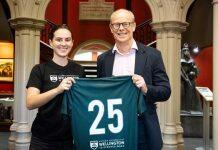The analysis of a person’s individual walking pattern, or gait, can reveal details about their identity and reflect differences between individuals, groups and even populations.


An international team of researchers, led by the University of Adelaide’s Kayne Duncanson, Associate Professor Dominic Thewlis, Dr Will Robertson and Dr Ehsan Abbasnejad, took a diverse profile of walking gait data from more than 700 people and trained artificial intelligence models to find similarities.
The research was published in The Journal of the Royal Society Interface .
Work is already being done around how relationships between gait and biological state can be used in healthcare and security, but until now, the fields used different methods.
“In healthcare, the aim is to use gait as a personal functional marker to assist in the management of neurological and musculoskeletal conditions, and measures are generally taken using multiple specialised instruments and small population samples,” said lead researcher Kayne Duncanson, a Higher Degree by Research candidate from the Adelaide Medical School.
“In security, the aim is to use it as a biometric to assist in-person recognition in dynamic settings, like surveillance at airports, or for authentication in smart homes.
“Gait recognition requires individual-level modelling to detect features that differ between individuals yet remain consistent within individuals over time.
“Hence, most studies focus on developing complex multivariate models such as deep neural networks to disentangle identifying features of gait from features relating to body appearance.
“Given that gait analysis methods in healthcare and security appear complementary, it could be beneficial to combine their strengths.”
Some of the data studied was collected from participants as they walked across a plate in the ground, known as a force platform.
The force platform measures the magnitude and point location of force at the ground in response to force applied through the feet, with the information then investigated using an explainable AI (XAI) method called occlusion sensitivity analysis and Uniform Manifold Approximation and Projection (UMAP).
“The first aim of this study was to determine if gait recognition performance differs depending on the dataset(s) used for model development and evaluation using different configurations of four large force platform gait datasets from around the world,” said Associate Professor Thewlis, Head of the Centre for Orthopaedic and Trauma Research.
“The second aim was to examine if demographic attributes and experimental conditions help to define gait variation using XAI.
“To fulfil these aims, a novel gait analysis method was proposed that enables simultaneous characterisation of individual, group, and dataset-level variation in gait patterns.”
What they found was the models, which were exposed to diversity while learning, were highly accurate in identifying people in various conditions.
“We found force platforms could be deployed as stand-alone instruments with relatively few constraints on sample selection and walking conditions to enable the acquisition of large datasets in laboratories, clinics and possibly more diverse environments, which could in turn facilitate more advanced data-driven decision making,” said Associate Professor Thewlis.
“Trends in performance and insights from XAI indicated that footwear, walking speed, body mass, sex, height and possibly other time-dependent factors interact to affect gait variation at multiple levels, and AI-based gait recognition systems which rely on force platform data show substantial promise for personalised analysis.”






































